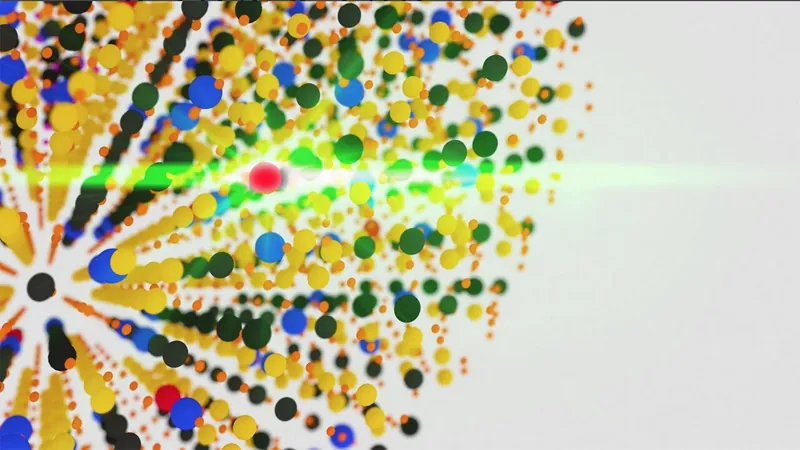
Groundbreaking All-Optical Nanoscale Force Sensors Set to Revolutionize Multiple Industries
2025-01-01
Author: Jia
Introduction
In an exciting development, researchers at Columbia Engineering have announced the creation of state-of-the-art nanoscale sensors that can remotely detect mechanical forces with unprecedented sensitivity and range. These innovative "all-optical" sensors utilize luminescent nanocrystals that change their intensity or color in response to mechanical stress, allowing for fully remote operation without the need for wires or connections—a significant advancement in sensor technology.
Importance of Mechanical Force Detection
Mechanical force plays a critical role in a myriad of physical and biological processes, from robotics and medical applications to cellular biophysics and even space exploration. Unfortunately, existing force sensors have limitations, particularly in the range of force magnitudes they can detect. Traditional nanoscale sensors are adept at measuring gentle piconewton forces, while larger devices can tackle micronewton levels. However, there is a considerable gap in sensitivity when it comes to remote measurements from subsurface or interfacial locations.
Breakthrough in Sensitivity and Range
Led by Professor Jim Schuck and postdoctoral scholar Natalie Fardian-Melamed, the Columbia team collaborated with researchers from Lawrence Berkeley National Laboratory, including the Cohen and Chan groups, to create a new class of nanosensors boasting a staggering 100-times better force sensitivity than current nanoparticles that rely on rare-earth ions. This breakthrough provides an operational range that extends over four orders of magnitude—a leap of up to 100 times larger than previously achievable with optical sensors.
Revolutionizing Optical Force Sensors
“Our discovery has the potential to revolutionize the capabilities of optical force sensors, drastically affecting technology in various fields, from robotics to cellular biology and even space travel,” Schuck stated emphatically.
Capabilities in Various Environments
One of the standout features of these nanosensors is their ability to operate effectively in previously inaccessible environments. Utilizing biocompatible and deeply penetrating infrared light, the sensors can analyze and monitor the health of diverse technological and biological systems. Imagine diagnosing issues deep within a battery or monitoring the development of an embryo, all without invasive procedures. This capability opens the door to early malfunction detection, which could have far-reaching implications for human health and sustainability.
Photon-Avalanching Effect
At the heart of this innovation is the photon-avalanching effect discovered by Schuck’s group. This nonlinear process allows for a single absorbed photon to trigger a reaction that emits many photons, enhancing measurement capabilities. The team’s research also revealed that the arrangement of lanthanide ions—rare-earth elements that make up the active components of the nanocrystals—plays a critical role in their sensitivity to mechanical forces.
Discovering Sensitivity During Research
“We stumbled upon this sensitivity while investigating the nanoparticle emissions,” Schuck shared. “The response exceeded our expectations, leading us to explore this remarkable force sensitivity further.”
Future Applications and Enhancements
The research team is now focused on applying these sensors in vital contexts, such as studying developing embryos, which could yield groundbreaking insights in developmental biology. Additionally, there are plans to enhance the sensors by integrating self-calibrating features, allowing each nanocrystal to act as a standalone sensor.
Commentary by Nobel Laureate
This achievement aligns with the recent commentary of Ardem Patapoutian, the 2021 Nobel Laureate, who emphasized the challenges of probing sensitive environmental processes in multiscale systems. Schuck and his team are at the forefront of transforming the sensing landscape, providing the means to dynamically and sensitively map critical changes in forces and pressures in real-world applications that have until now remained elusive.
Conclusion
With the potential to disrupt current technologies on many fronts, these all-optical nanoscale sensors signal a new era of precision in force measurement, promising immense improvements for industries focused on health, energy, and beyond.


 Brasil (PT)
Brasil (PT)
 Canada (EN)
Canada (EN)
 Chile (ES)
Chile (ES)
 Česko (CS)
Česko (CS)
 대한민국 (KO)
대한민국 (KO)
 España (ES)
España (ES)
 France (FR)
France (FR)
 Hong Kong (EN)
Hong Kong (EN)
 Italia (IT)
Italia (IT)
 日本 (JA)
日本 (JA)
 Magyarország (HU)
Magyarország (HU)
 Norge (NO)
Norge (NO)
 Polska (PL)
Polska (PL)
 Schweiz (DE)
Schweiz (DE)
 Singapore (EN)
Singapore (EN)
 Sverige (SV)
Sverige (SV)
 Suomi (FI)
Suomi (FI)
 Türkiye (TR)
Türkiye (TR)
 الإمارات العربية المتحدة (AR)
الإمارات العربية المتحدة (AR)